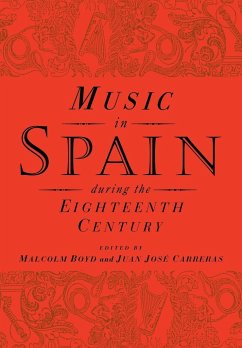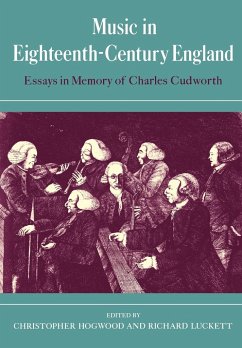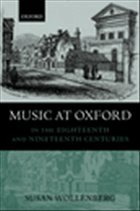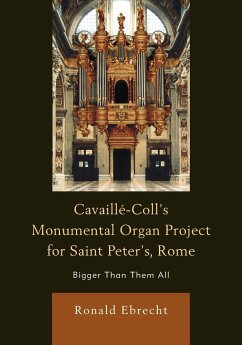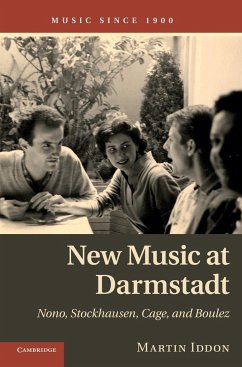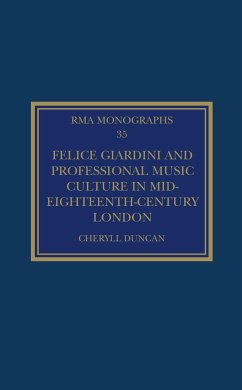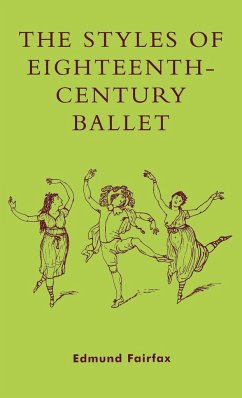
Music in Eighteenth-Century Austria

PAYBACK Punkte
23 °P sammeln!
An examination of the little-understood period of music history in which Haydn, Mozart and Beethoven worked.The music of Haydn, Mozart and Beethoven forms a cornerstone of the modern repertoire, but very little is known about the context in which these composers worked. This volume of twelve essays by leading international scholars considers some of the musical traditions and practices of this little-understood period of music history. Beginning with the early decades of the eighteenth century, the volume documents selected aspects of musical life and style from the late Baroque period through...
An examination of the little-understood period of music history in which Haydn, Mozart and Beethoven worked.
The music of Haydn, Mozart and Beethoven forms a cornerstone of the modern repertoire, but very little is known about the context in which these composers worked. This volume of twelve essays by leading international scholars considers some of the musical traditions and practices of this little-understood period of music history. Beginning with the early decades of the eighteenth century, the volume documents selected aspects of musical life and style from the late Baroque period through to the early years of the nineteenth century. The four main areas covered in this exploration of new territories in music history are orchestral music, sacred music, opera and keyboard music. Georg Reutter (Haydn's teacher), Antonio Salieri (Mozart's colleague) and Wölffl (a rival of Beethoven) are just three of the period's prominent musicians who are discussed at length.
Review quote:
'- the papers make a substantial contribution to our understanding and knowledge of the topics they cover.' The Musical Times
'The book stands as an excellent contribution to modern research. The editor's introductory essay outlines genuinely new perspectives, and it ends, appropriately, with the statement 'Larsen's Challenge to Musicology' remains.' Opera Quarterly
Table of contents:
List of plates; Preface; 1. Introduction: new challenges, new perspectives David Wyn Jones; Part I. Overture, Symphony and Concerto: 2. The trumpet overture and sinfonia in Vienna (1715-1822): rise, decline and reformulation A. Peter Brown; 3. The early Classical violin concerto in Austria Chappell White; Part II. Traditions in Sacred Music: 4. Haydn's Missa sunt bona mixta malis and the a cappella tradition David Wyn Jones; 5. Johann Baptist Vanhal and the pastoral mass tradition Bruce MacIntyre; 6. The Austrian pastorella and the stylus rusticanus: comic and pastoral elements in Austrian music, 1750-1800 Geoffrey Chew; Part III. Opera and Drama: 7. The applausus musicus, or Singgedicht: a neglected genre of eighteenth-century musical theatre Robert N. Freeman; 8. The operas of Antonio Salieri as a reflection of Viennese opera 1770-1800 John A. Rice; 9. Lorenzo da Ponte's Viennese librettos Konrad Küster; 10. Viennese amateur or London professional? A reconsideration of Haydn's tragic cantata Arianna a Naxos Julian Rushton; Part IV. Pianos and Pianism: 11. The Viennese fortepiano in the eighteenth century Eva Badura-Skoda; The Beethoven-Wölfl piano duel Tia DeNora; Index.
The music of Haydn, Mozart and Beethoven forms a cornerstone of the modern repertoire, but very little is known about the context in which these composers worked. This volume of twelve essays by leading international scholars considers some of the musical traditions and practices of this little-understood period of music history. Beginning with the early decades of the eighteenth century, the volume documents selected aspects of musical life and style from the late Baroque period through to the early years of the nineteenth century. The four main areas covered in this exploration of new territories in music history are orchestral music, sacred music, opera and keyboard music. Georg Reutter (Haydn's teacher), Antonio Salieri (Mozart's colleague) and Wölffl (a rival of Beethoven) are just three of the period's prominent musicians who are discussed at length.
Review quote:
'- the papers make a substantial contribution to our understanding and knowledge of the topics they cover.' The Musical Times
'The book stands as an excellent contribution to modern research. The editor's introductory essay outlines genuinely new perspectives, and it ends, appropriately, with the statement 'Larsen's Challenge to Musicology' remains.' Opera Quarterly
Table of contents:
List of plates; Preface; 1. Introduction: new challenges, new perspectives David Wyn Jones; Part I. Overture, Symphony and Concerto: 2. The trumpet overture and sinfonia in Vienna (1715-1822): rise, decline and reformulation A. Peter Brown; 3. The early Classical violin concerto in Austria Chappell White; Part II. Traditions in Sacred Music: 4. Haydn's Missa sunt bona mixta malis and the a cappella tradition David Wyn Jones; 5. Johann Baptist Vanhal and the pastoral mass tradition Bruce MacIntyre; 6. The Austrian pastorella and the stylus rusticanus: comic and pastoral elements in Austrian music, 1750-1800 Geoffrey Chew; Part III. Opera and Drama: 7. The applausus musicus, or Singgedicht: a neglected genre of eighteenth-century musical theatre Robert N. Freeman; 8. The operas of Antonio Salieri as a reflection of Viennese opera 1770-1800 John A. Rice; 9. Lorenzo da Ponte's Viennese librettos Konrad Küster; 10. Viennese amateur or London professional? A reconsideration of Haydn's tragic cantata Arianna a Naxos Julian Rushton; Part IV. Pianos and Pianism: 11. The Viennese fortepiano in the eighteenth century Eva Badura-Skoda; The Beethoven-Wölfl piano duel Tia DeNora; Index.





